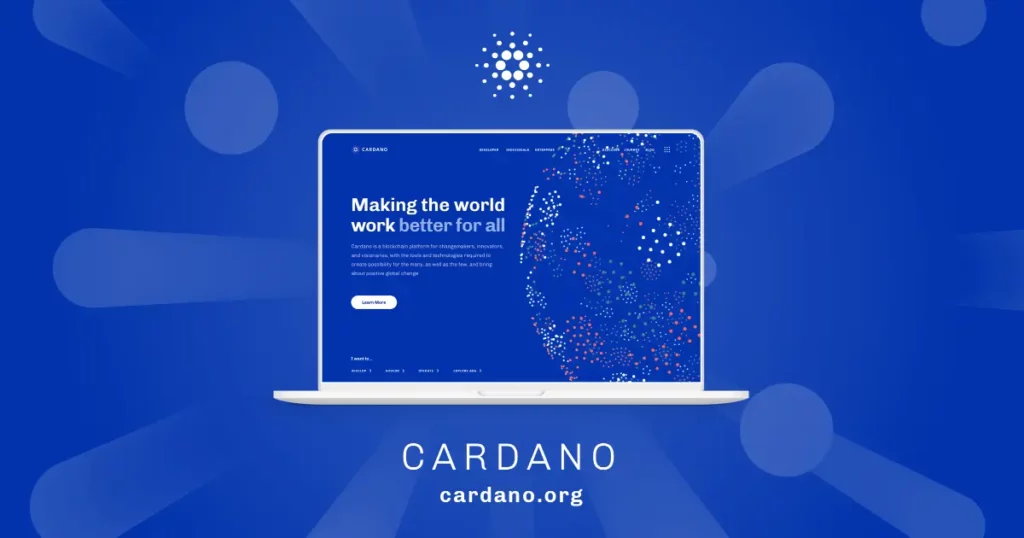No products in the cart.
Blog
Exploring 19 Fascinating Facts About Cardano
Cardano has emerged as a prominent player in the world of blockchain and cryptocurrency, known for its innovative approach and commitment to sustainability. If you’re curious about this exciting project, here are 15 facts about Cardano that showcase its unique features and contributions to the crypto space.
Cardano is a cryptocurrency and decentralized platform that aims to provide a secure and scalable infrastructure for the development of decentralized applications (DApps) and smart contracts. Launched in 2017 by blockchain development company IOHK, Cardano was founded by Ethereum co-founder Charles Hoskinson. It is designed to be a third-generation blockchain, addressing scalability, sustainability, and interoperability issues that some earlier blockchains faced.
ADA Genesis Block: 13th September 2017
On September 13, 2017, Cardano embarked on its revolutionary journey with the creation of the ADA Genesis Block. This marked the birth of Cardano’s blockchain, a meticulously crafted proof-of-stake platform designed for scalability, sustainability, and interoperability. The Genesis Block initiation symbolizes the commitment to pioneering blockchain technology, setting Cardano apart in the cryptocurrency landscape.

95% of ADA Supply Already in Circulation
Cardano’s unique approach to token distribution sets it apart from many other cryptocurrencies. Notably, approximately 95% of the total ADA supply is already in circulation, an intentional design choice fostering liquidity and reducing the impact of large token holders on market dynamics. This distinguishes Cardano as a project committed to fairness and widespread token ownership, providing a solid foundation for a decentralized and inclusive ecosystem.
Cardano Uses A Fraction Of The Energy Of Ethereum Or Bitcoin

Bitcoin utilizes an annual energy amount comparable to that of the entire Netherlands. Ethereum’s consumption, although less than half of Bitcoin’s, still equates to the energy usage of a smaller country like Portugal.
Cardano stands out as an environmentally friendly cryptocurrency, consuming roughly the same energy as 600 U.S. homes annually.
3rd Generation Network
Cardano is classified as a third-generation network, distinguishing it from the first-generation network, Bitcoin, and the second-generation network, Ethereum. It incorporates the strengths of various existing blockchains, presenting features such as scalability, interoperability, sustainability, and the ability to store metadata for each transaction.
Ouroboros Consensus Algorithm: 10,000 Transactions Per Second

Cardano’s Ouroboros consensus algorithm is a technological marvel, showcasing the platform’s commitment to scalability. Capable of handling up to 10,000 transactions per second, Ouroboros positions Cardano as a high-performance blockchain.
This scalability is essential for accommodating a growing user base and a wide range of decentralized applications, making Cardano an attractive choice for developers seeking an efficient and future-proof blockchain infrastructure.
Cardano Has Been In The Top 10 Cryptos Since It Launched
Founded by Charles Hoskinson, a co-founder of Ethereum who departed due to a disagreement on its management, Cardano has been a project driven by a determination to innovate.
Charles Hoskinson, considered a cryptocurrency luminary, was resolute about implementing a unique approach from the project’s inception. The entire development process of the platform has involved rigorous peer review, with experts meticulously constructing this new blockchain from the ground up.
This commitment to a meticulous development process has been reflected in ADA’s consistent presence in the top 10 coins by market capitalization since its launch in 2015.
21.6 Billion ADA Maximum Supply

Cardano’s monetary policy is anchored in a capped supply of 45 billion ADA, with over 21.6 billion currently in circulation. This finite supply aligns with economic principles of scarcity, potentially influencing ADA’s value over time. With a responsibly managed supply, Cardano aims to create a digital currency that balances utility and value preservation, contributing to its appeal as a long-term investment.
Over 3,000 Staking Pools
The widespread adoption of Cardano’s staking model is evident in the existence of over 3,000 staking pools. This decentralized approach empowers ADA holders to actively participate in securing the blockchain and earning rewards.
The plethora of staking pools not only ensures a distributed and secure network but also reflects the vibrant and engaged nature of the Cardano community, showcasing the enthusiasm for actively contributing to the platform’s success.
Cardano Is Working With Governments In Africa

Establishing a team in Ethiopia for an extended period, Cardano has actively engaged with governments and ministries throughout the continent. Their most significant project to date emerged from a recent landmark collaboration with the Ethiopian Ministry of Education.
This collaboration utilizes the Cardano platform to develop digital IDs for 5 million students. These IDs aim to provide each student with a secure and unalterable academic record that remains with them indefinitely. As students transition into the workforce or pursue higher education, these IDs serve as verifiable proof of their academic achievements.
Cardano Has A Maximum Supply Cap Of 45 Billion Tokens
Concerning token supply and distribution, the protocol caps the maximum allowable circulation of ADA at 45 billion, a measure implemented to prevent drastic price declines. Currently, the circulating supply stands at approximately 31 billion in its initial offering in 2017.
Examining token price and market performance, Cardano’s value experienced fluctuations, ranging from $0.02 to $1.21 per token over the past year. Simultaneously, ADA’s market capitalization fluctuated between $8.43 billion and $40.9 billion within the same timeframe. The record high price for Cardano was noted at $2.92 as of February 24, 2023.
Cardano’s Academic Roots: 21 Research Papers

Cardano’s commitment to scientific excellence is underlined by its publication of 21 research papers. These academic contributions span a range of topics, from consensus algorithms to smart contract languages. The emphasis on rigorous research positions Cardano as a thought leader in the blockchain space, fostering an environment where innovation is driven by intellectual curiosity and peer-reviewed exploration.
Cardano And Its Many-Headed Hydra
Discussing cryptocurrency often delves into technicalities, and Cardano is no exception. Employing a layered blockchain structure for transaction tracking and data storage, Cardano’s blockchain functions like a sophisticated database, composed of interconnected blocks.
Analogous to an express checkout at a grocery store, Hydra operates atop the primary blockchain. While the fundamental blockchain manages substantial monthly transactions, Hydra caters to quick transactions of 10 items or fewer.
Cardano Is Faster Than Visa’s Processing Capabilities Of 65,000 Transactions Per Second (Tps)

Cardano boasts transaction processing capabilities that surpass even Visa’s renowned speed, which stands at 65,000 transactions per second (TPS). The platform’s innovative architecture and second-layer technology, known as Hydra, enable it to outpace Visa’s processing speed.
With Hydra acting as an additional layer on top of the primary blockchain, Cardano achieves an impressive scale. Each component of Hydra, referred to as a “Hydra head,” can handle up to 1,000 TPS.
Cardano Provides Financial Services To The 1.7 Billion Unbanked Individuals
Cardano is pioneering financial inclusivity by extending its services to the 1.7 billion unbanked individuals worldwide. Through its innovative blockchain technology and commitment to real-world applications, Cardano aims to bridge the gap by offering accessible financial services to those who have traditionally been excluded from the formal banking system.
This initiative seeks to empower underserved communities, providing them with opportunities for economic participation and growth that were previously inaccessible.
ADA Has Approximately 32 Billion Forged Coins In Circulation

ADA stands among the top three global cryptocurrencies, with a current market capitalization reaching $85 billion this week. The circulating supply of ADA is around 32 billion out of a maximum supply of 45 billion. Notably, some of the ADA not currently in circulation is part of the public fund for the Catalyst Project. These reserved coins are intended to serve as incentives when the community engages in voting for innovations within the Cardano ecosystem.
80% of ADA Addresses Hold Less Than 1% of Total Supply
Cardano’s commitment to decentralization is mirrored in the distribution of ADA, with around 80% of addresses holding less than 1% of the total supply. This equitable ownership structure mitigates the risk of wealth concentration, promoting a fair and inclusive ecosystem.
Cardano’s focus on preventing the undue influence of a few entities aligns with the ethos of decentralization, ensuring that decision-making power is distributed across a diverse range of participants.
Shelley Upgrade: 1,000 Stake Pools
The Shelley upgrade, a pivotal moment in Cardano’s development, heralded the era of decentralization. With the creation of over 1,000 stake pools, Cardano achieved a significant milestone in its mission to distribute network validation.
This widespread participation enhances the security and resilience of the blockchain, ensuring that no single entity can dominate the decision-making processes, a key tenet of Cardano’s commitment to decentralization.

Cardano’s Pioneering Africa Strategy: 5 African Countries
Cardano’s strategic focus on Africa involves partnerships in five countries on the continent. This pioneering approach aims to leverage blockchain technology for technological innovation and financial inclusion.
By addressing real-world challenges through partnerships and initiatives, Cardano demonstrates its commitment to creating meaningful impact, harnessing blockchain’s transformative potential to uplift communities and drive positive socio-economic change in the African context.
Project Catalyst: $250 Million in Community Funding
Project Catalyst, Cardano’s decentralized governance initiative, allocates a substantial $250 million for community-driven projects. This unique approach empowers the Cardano community to actively shape the ecosystem’s future.
By providing significant funding for community initiatives, Cardano ensures that its development is influenced by a diverse range of perspectives, enhancing the resilience and adaptability of the platform. This commitment to community-driven governance sets Cardano apart, fostering a sense of ownership and collaboration that is foundational to its success.
Conclusion
In conclusion, Cardano stands out for its commitment to scientific rigor, sustainable consensus algorithm, and innovative approach to blockchain development. As the project continues to evolve, it is likely to play a significant role in shaping the future of decentralized finance and blockchain technology.


